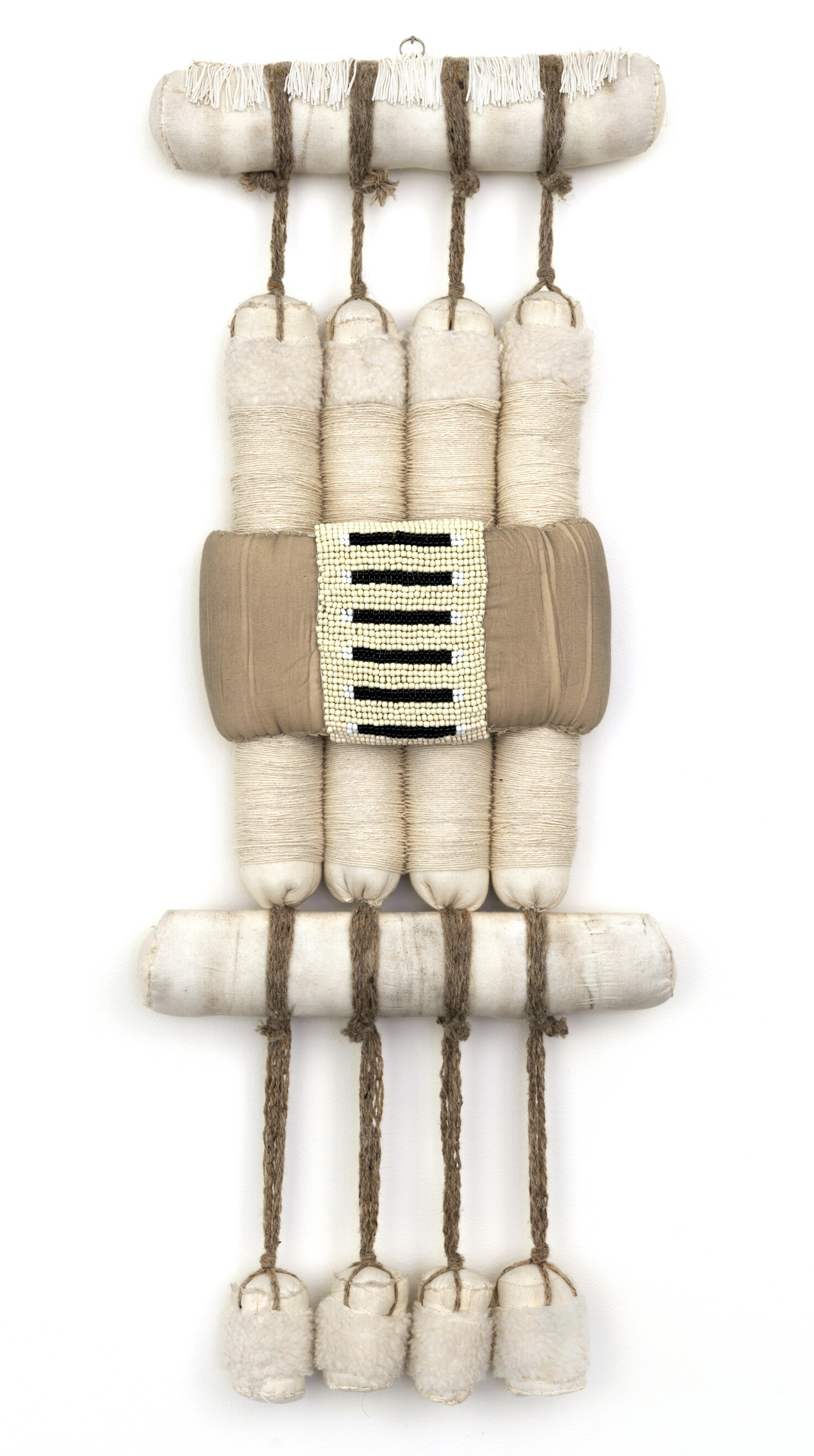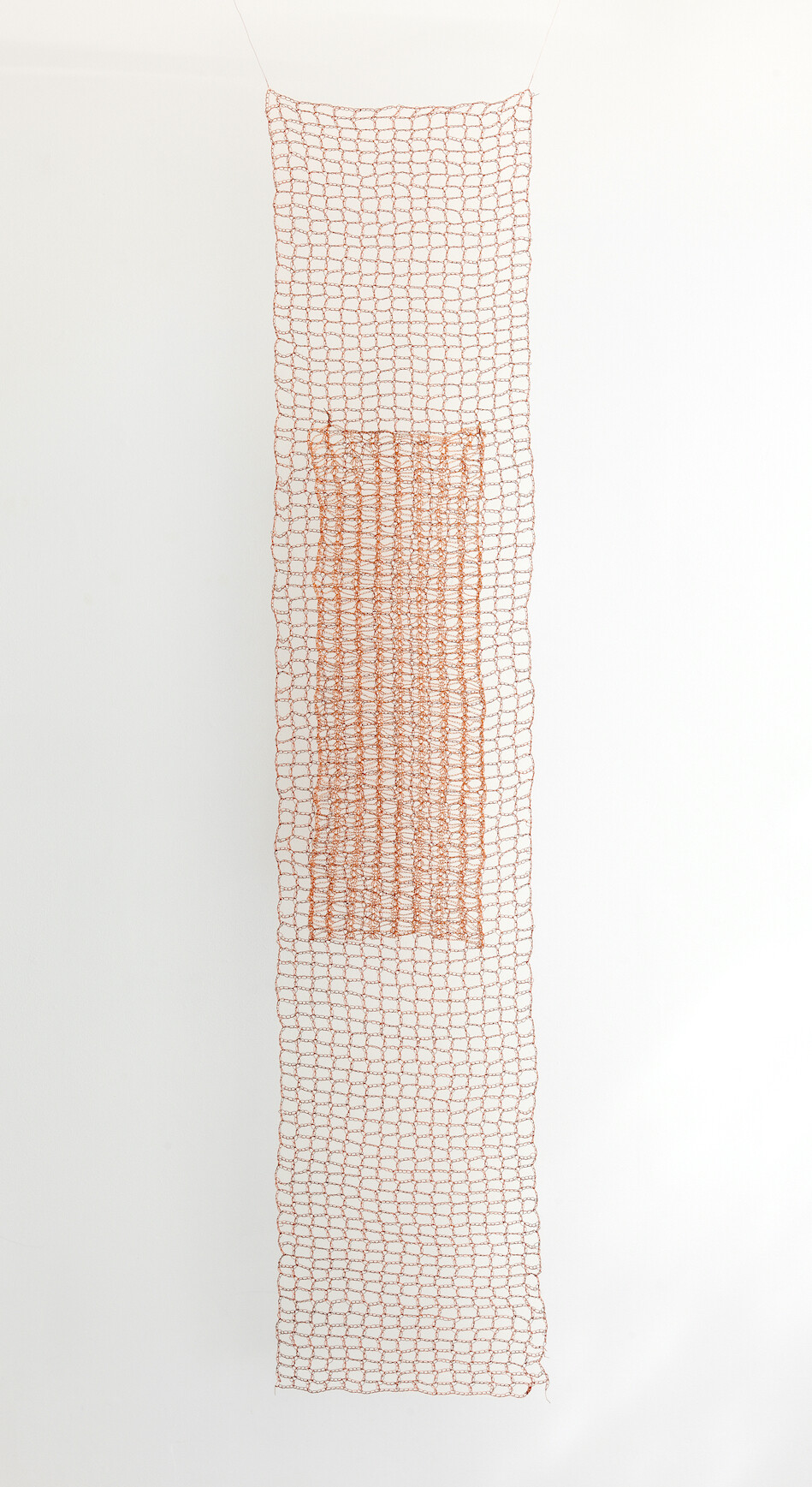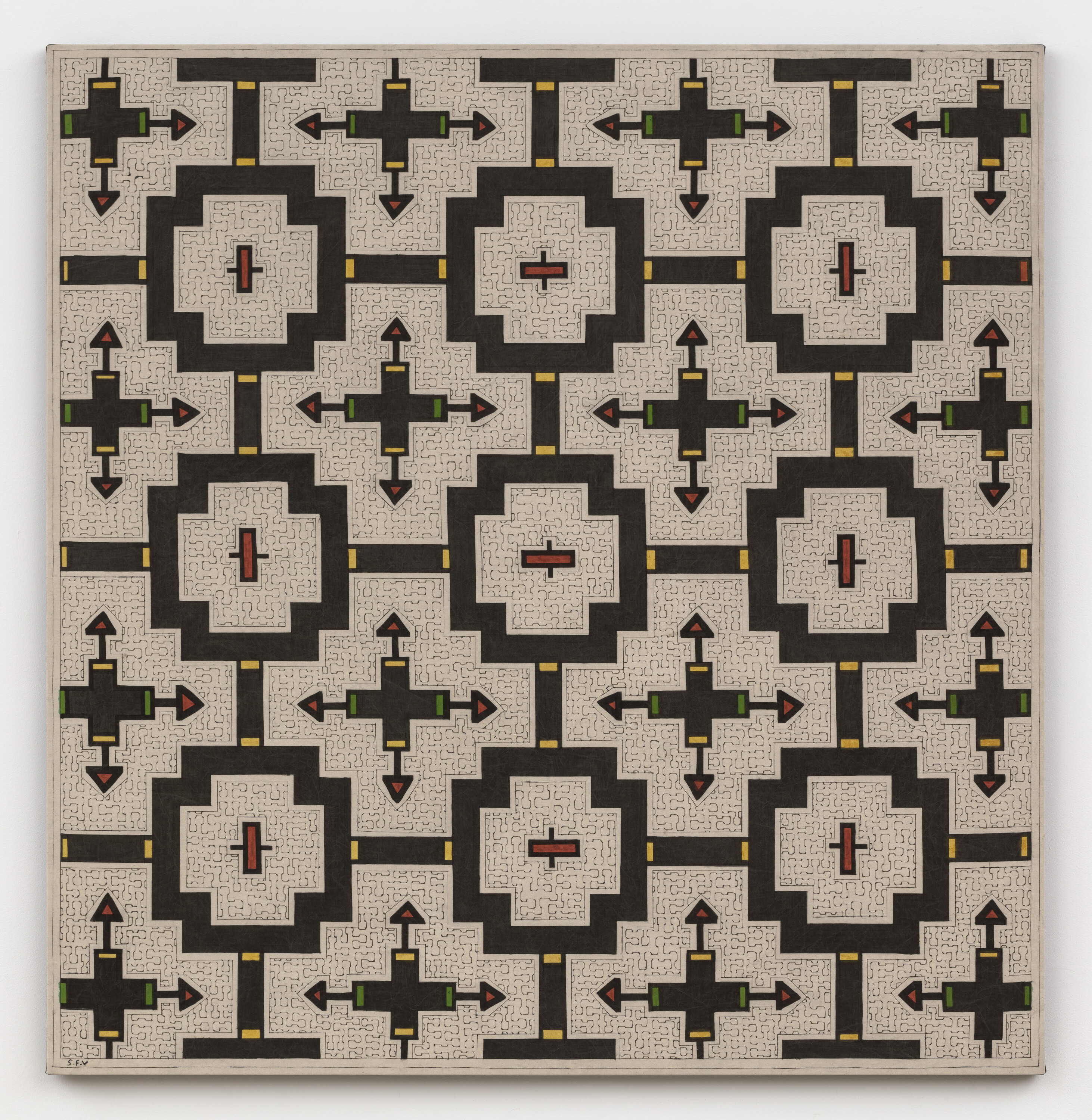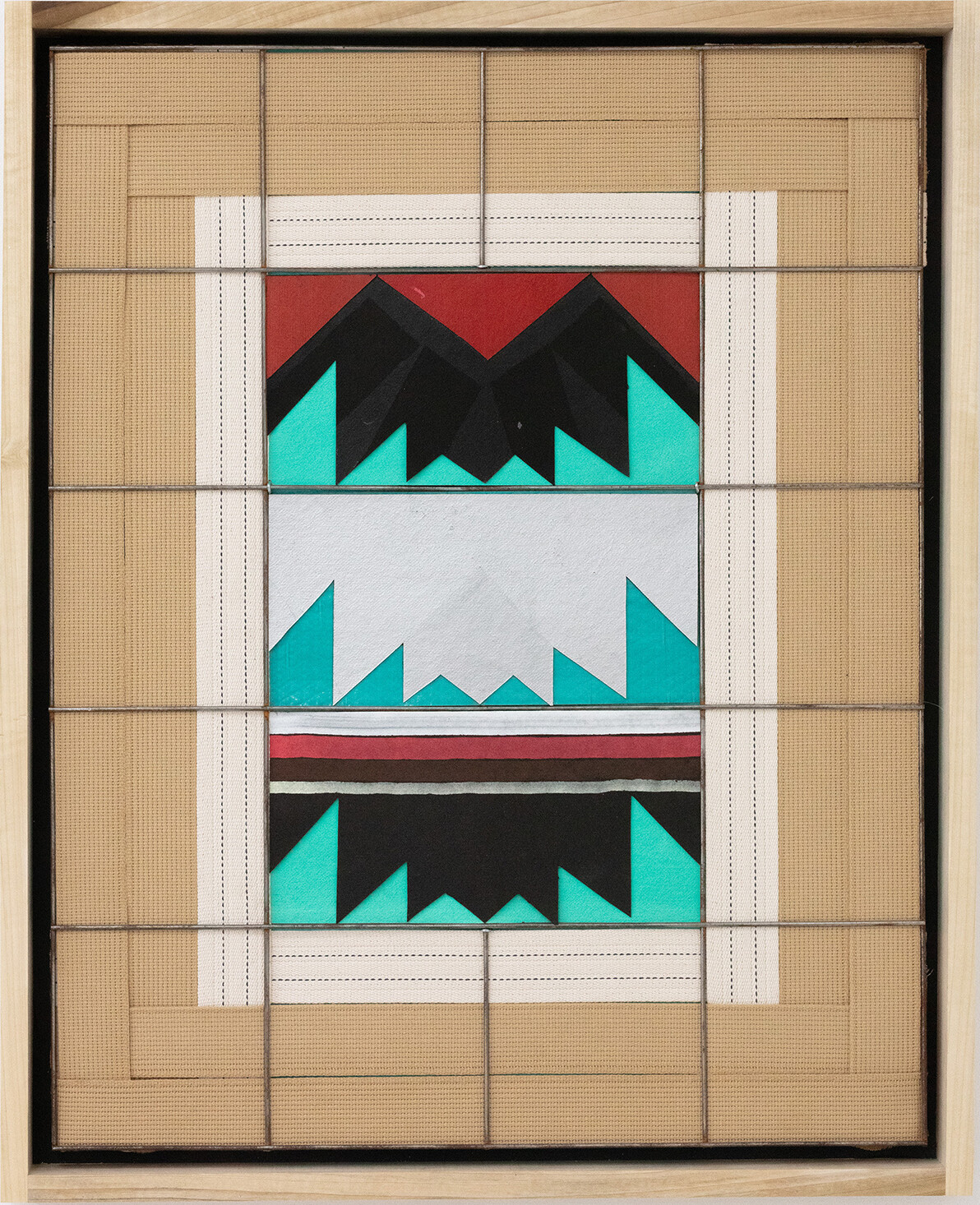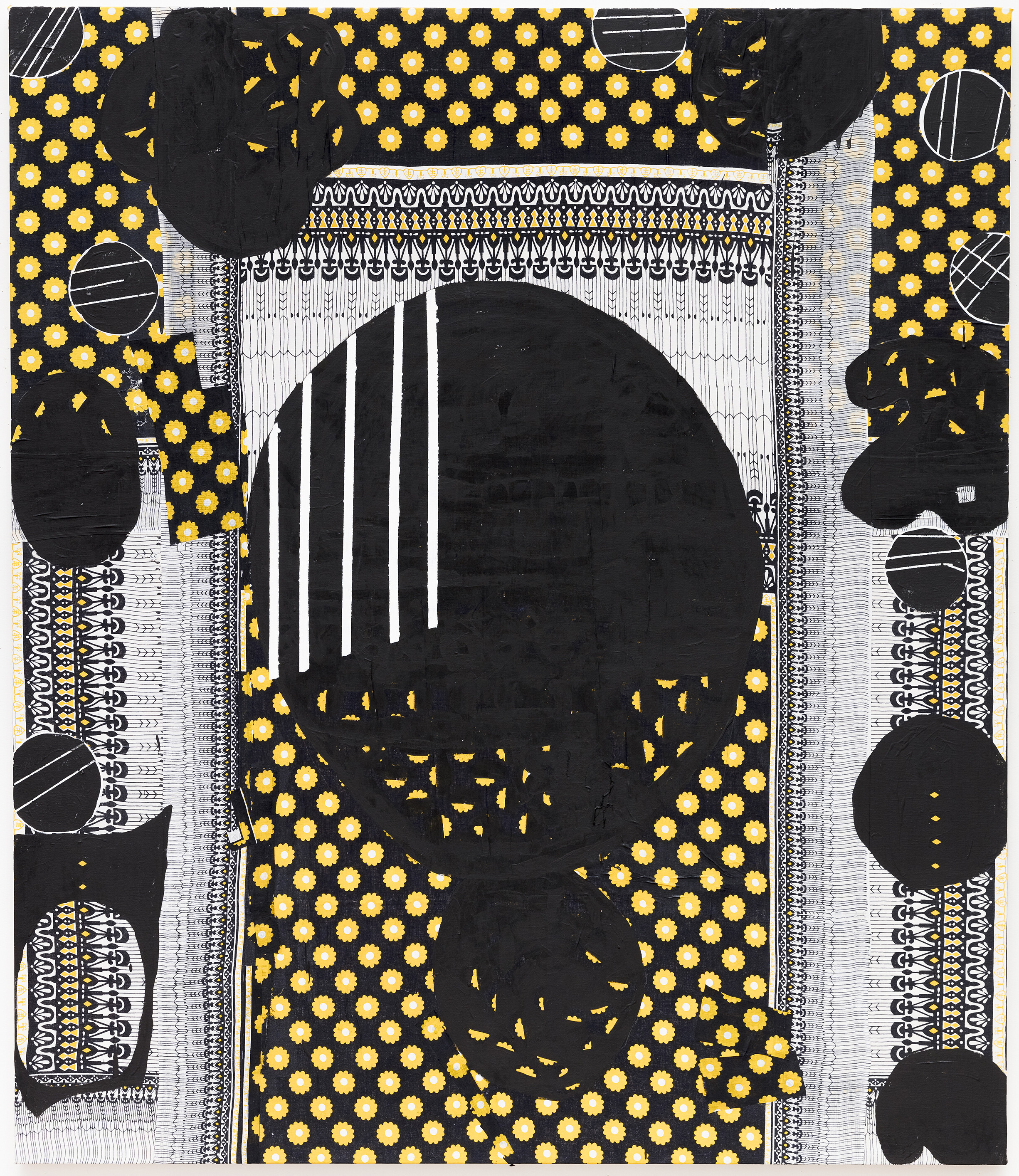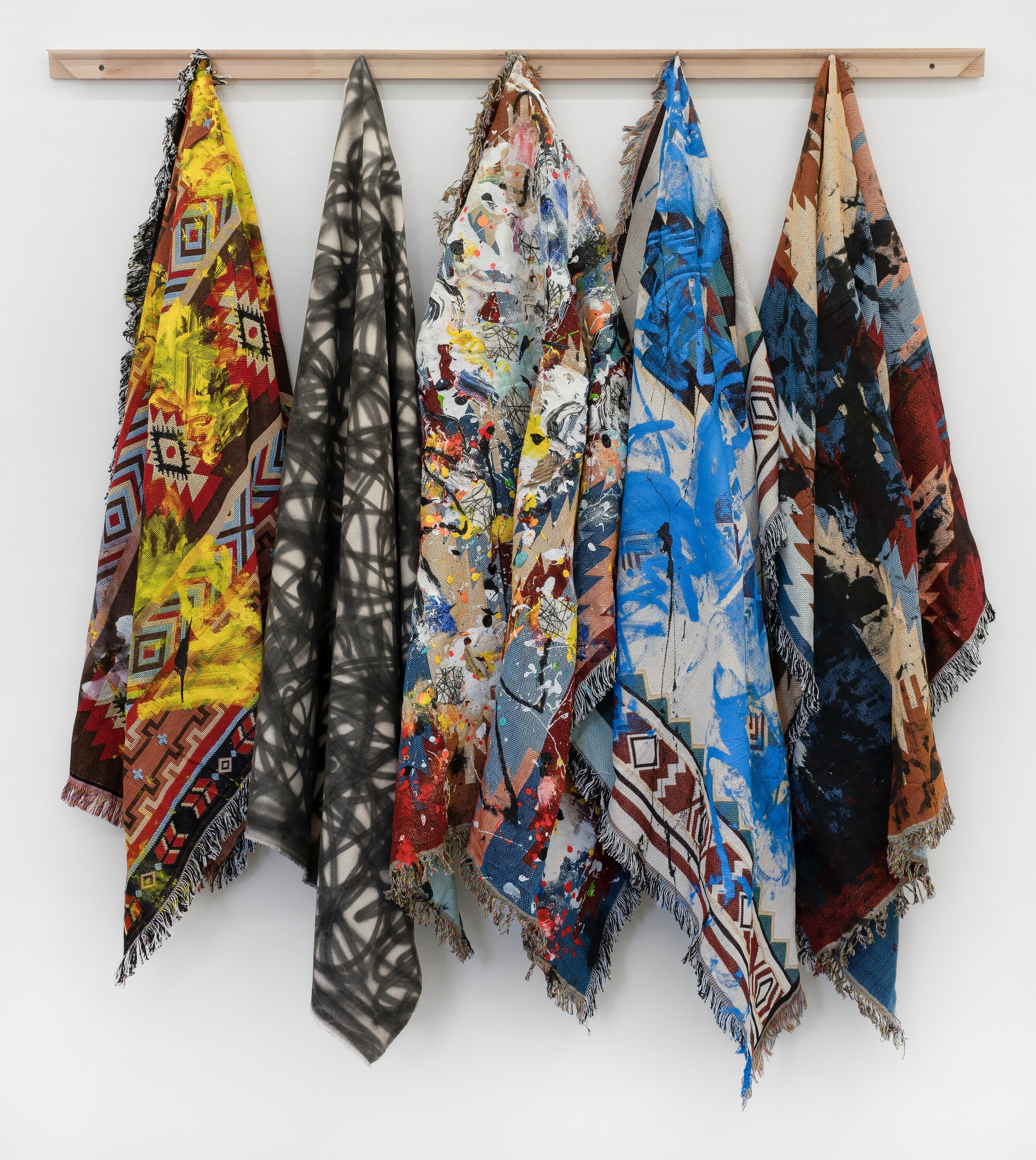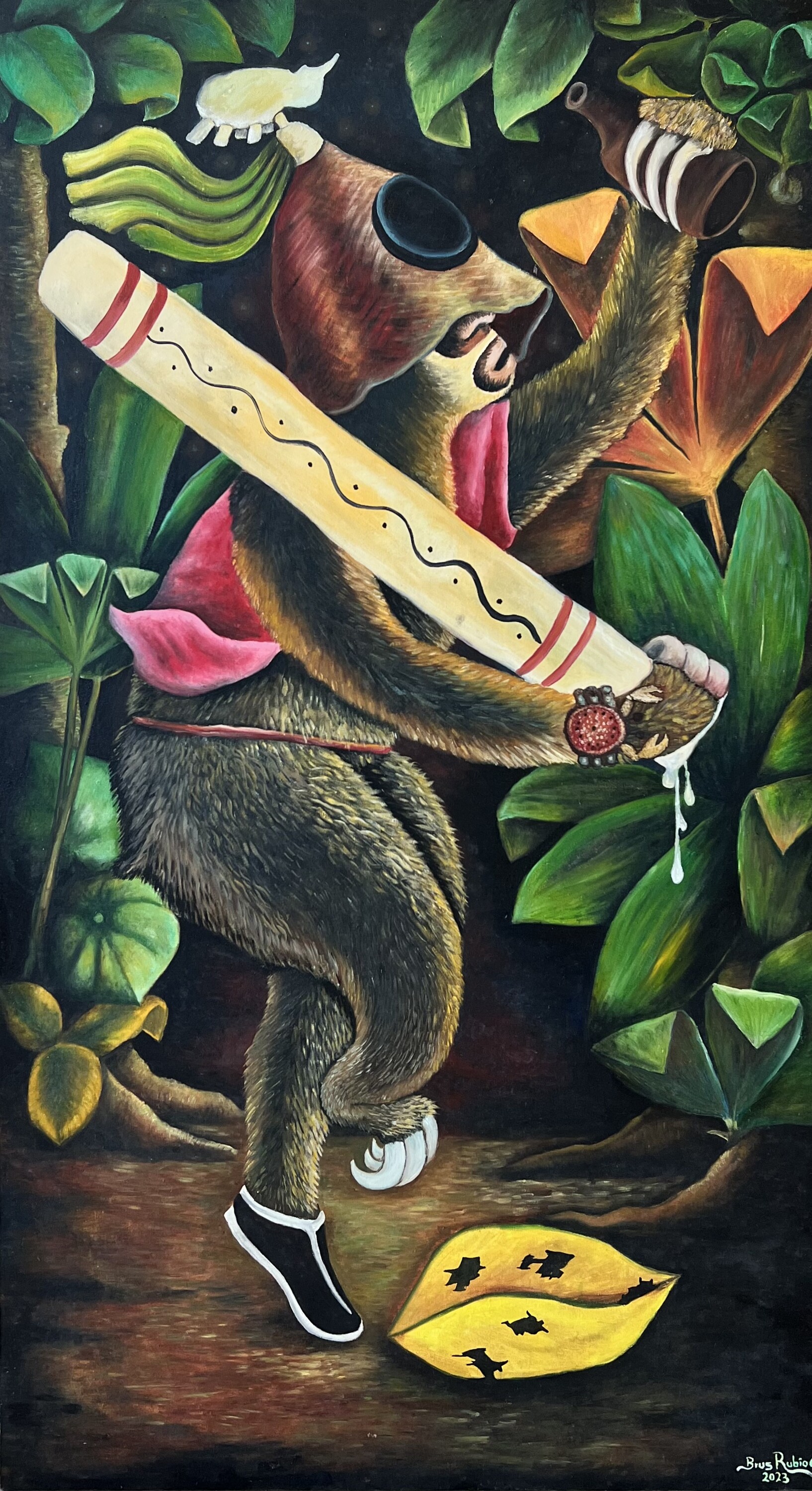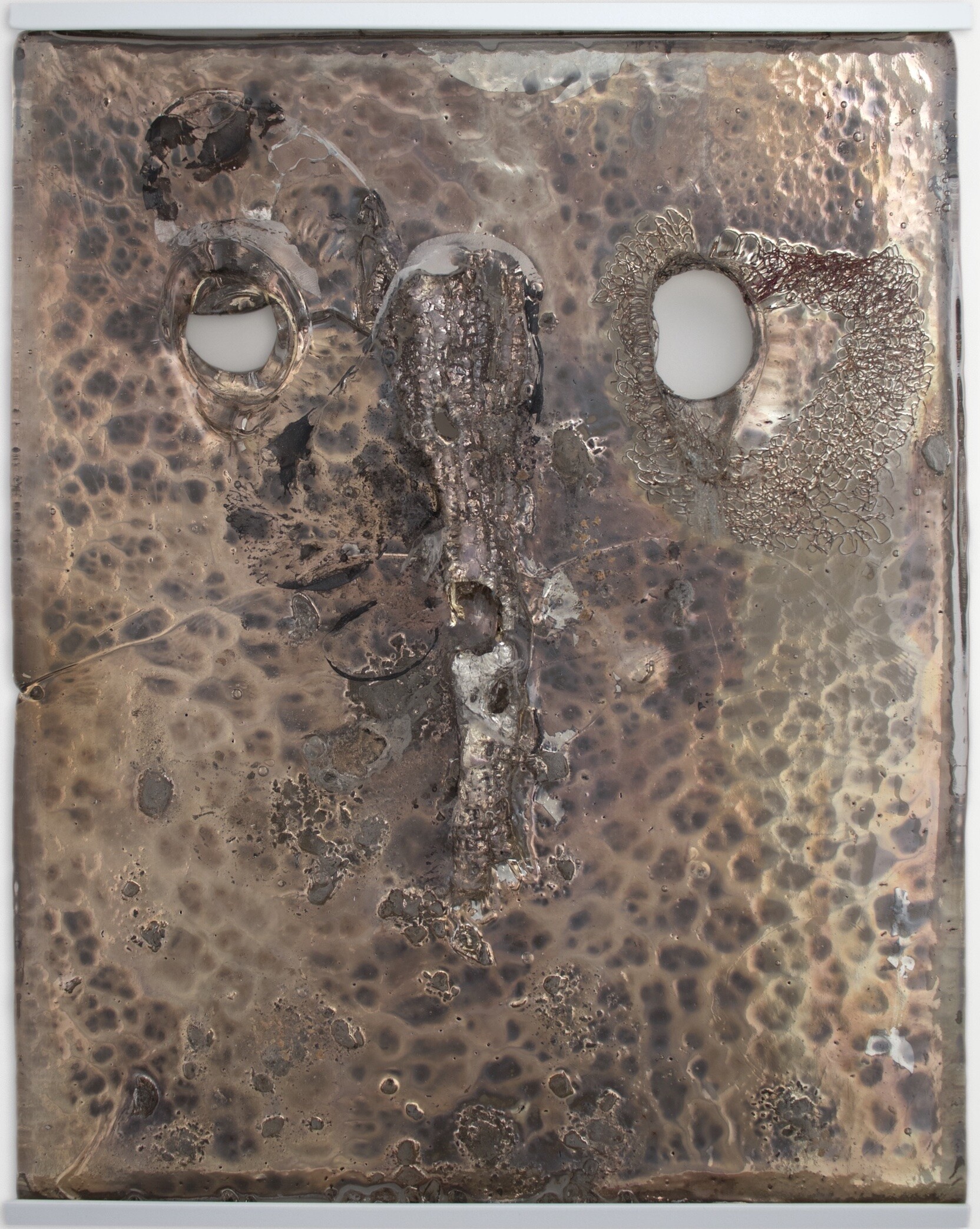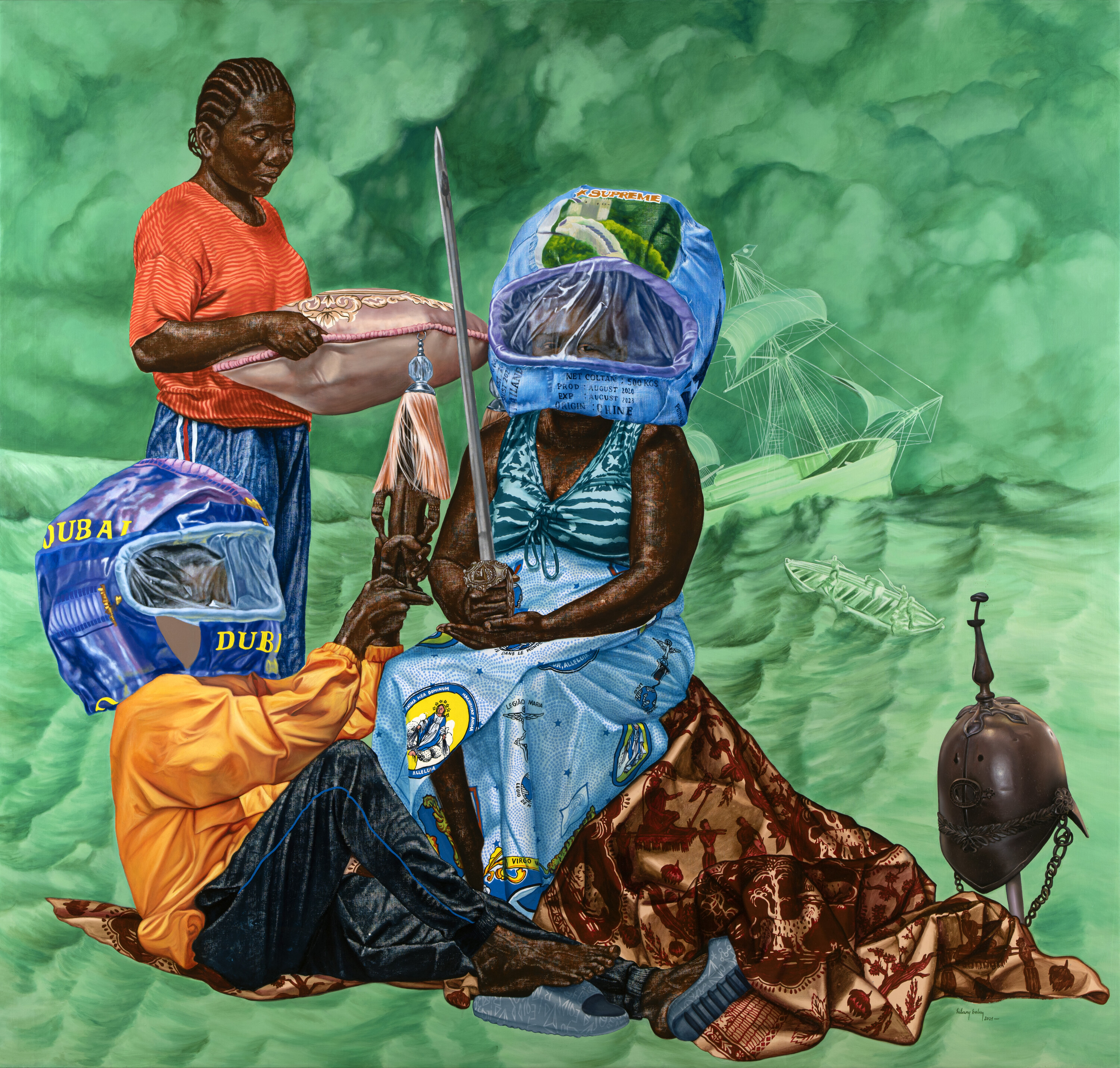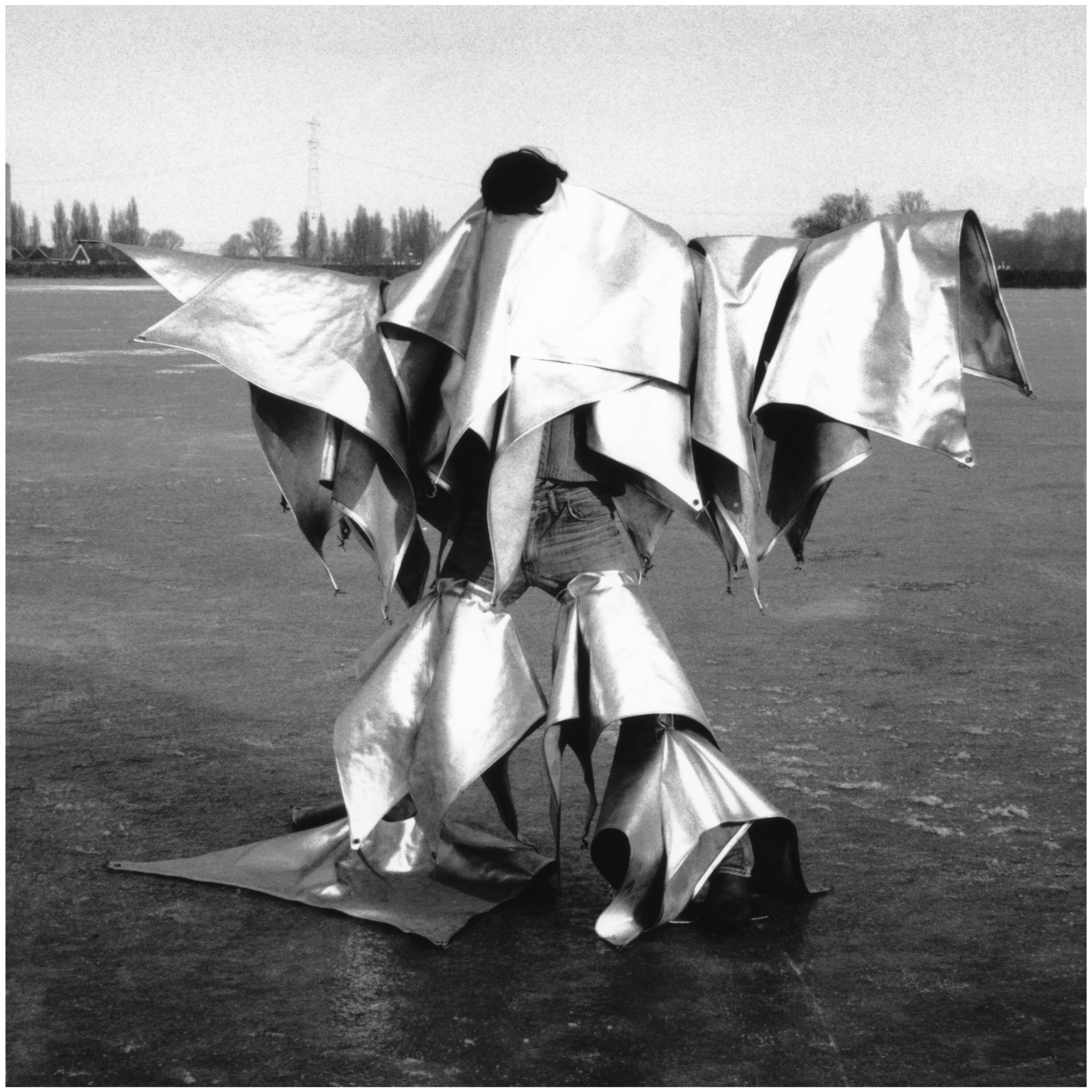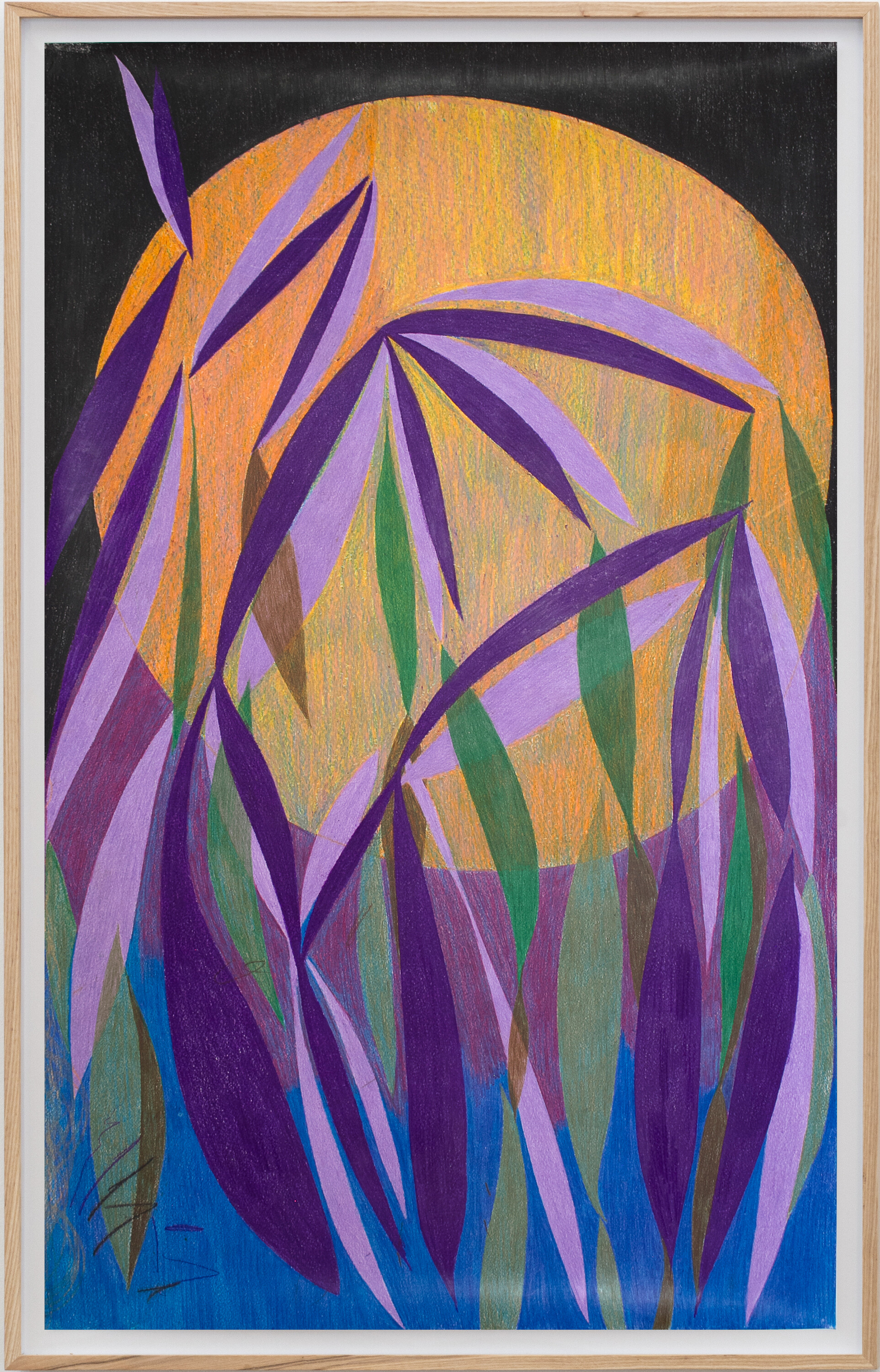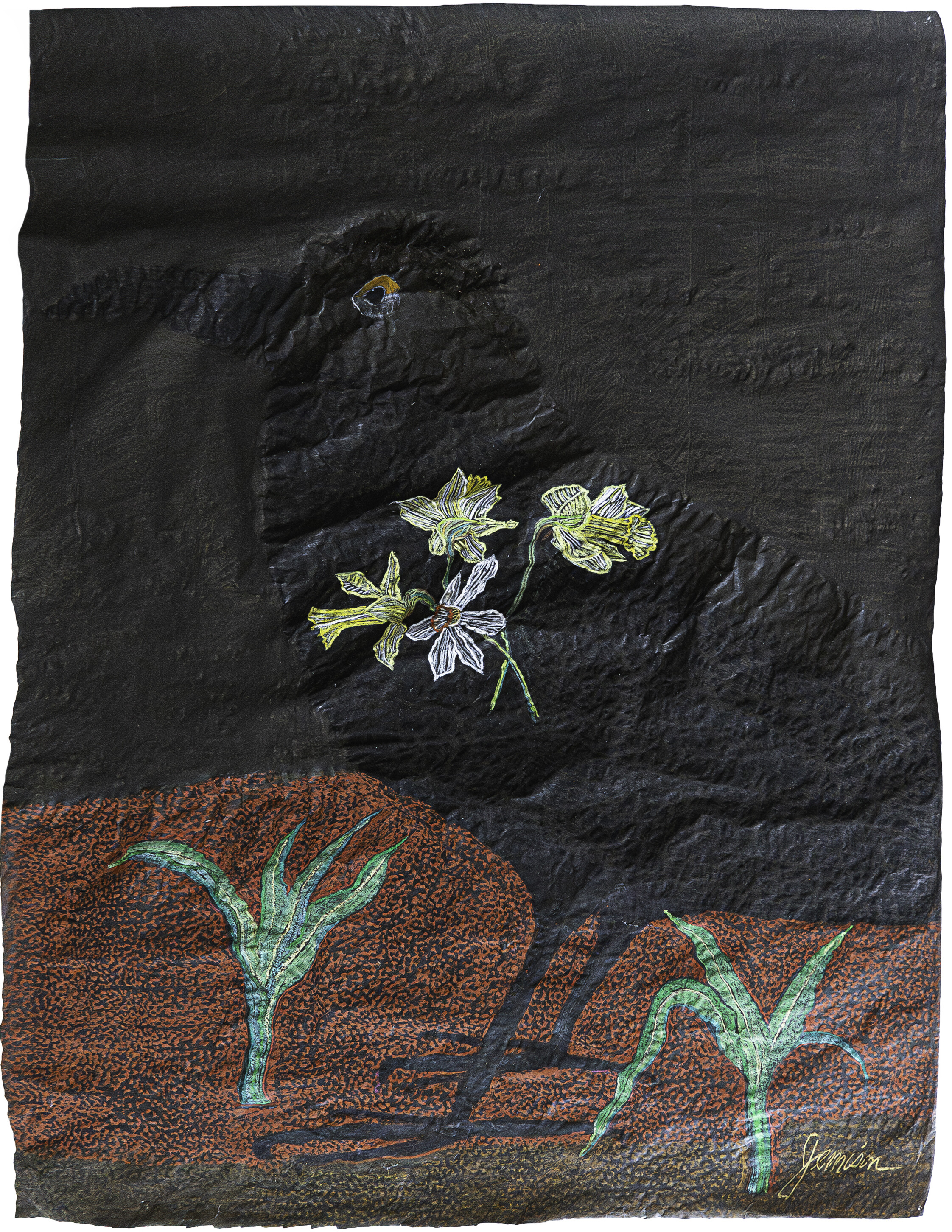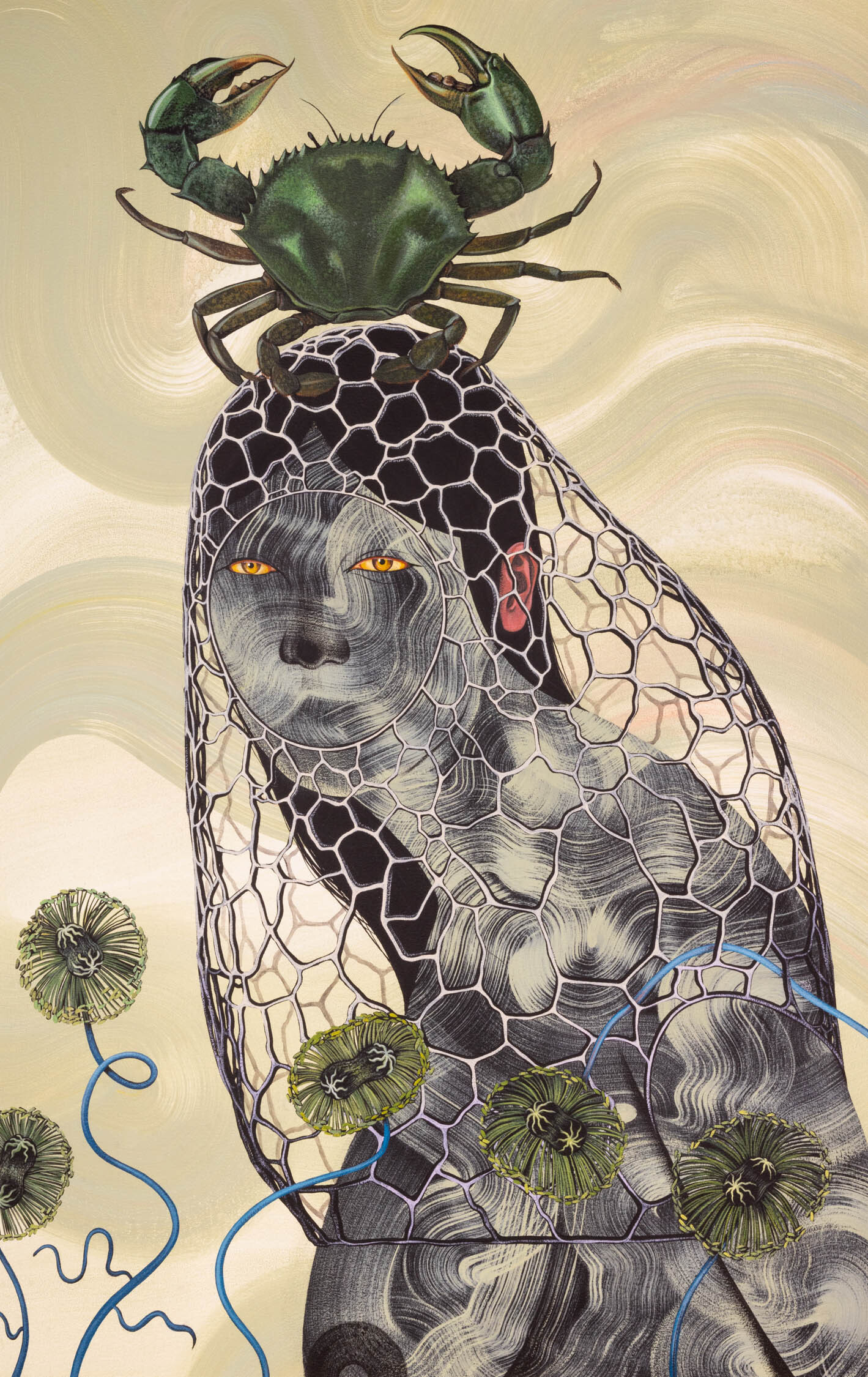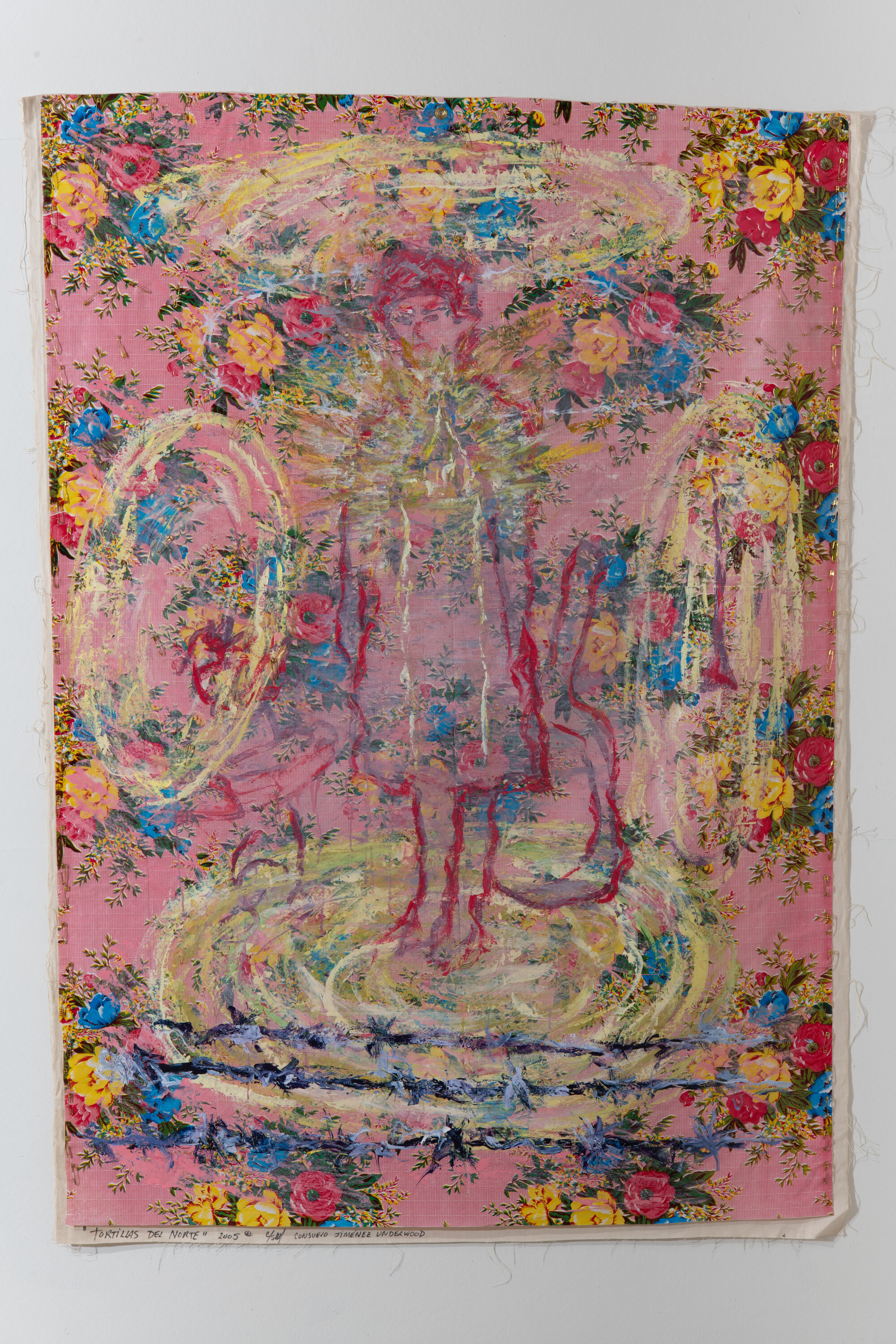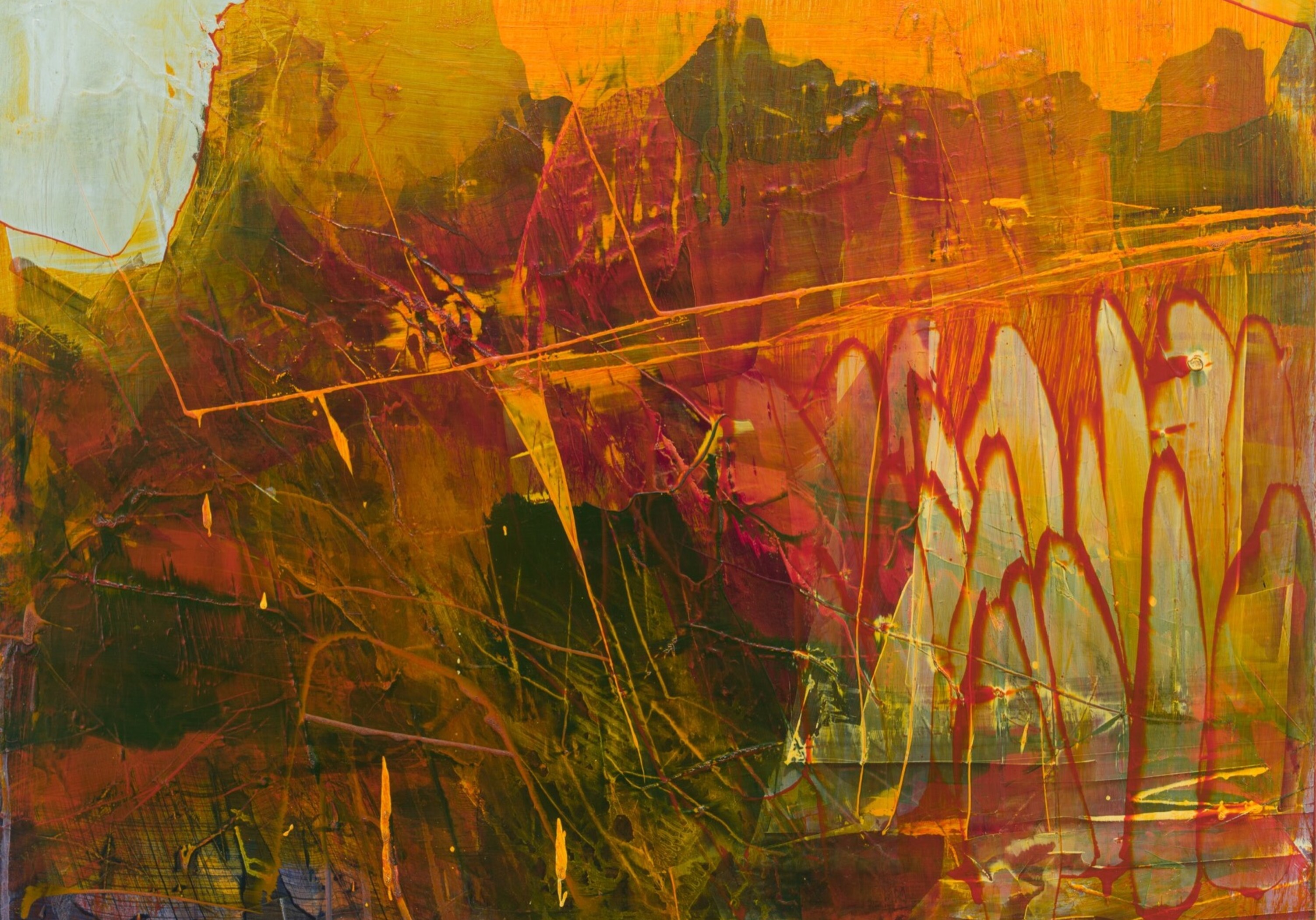
Explore the projects in Focus 2023, Inheritances: material and otherwise, curated by Candice Hopkins.
The artists in the Focus section use materials to manifest histories—whether sedimented or surfaced, place based or familial, learned or reclaimed—and to conjure specific futures. Some of the sculptures in this section call for different protocols of engagement, that go beyond mere viewing. For example, oversized soft sculptures of Navajo jewelry form the basis for works that produce sound and are activated through performance, while percussive sculptures draw on a lifelong exploration of how the body generates its own rhythms to illuminate the permeability of the border between art and science. Other works incorporate jingles, and reference anthems, and patterns from the powwow circuit, a mass movement that serves as both a means of gathering for Native American people across Turtle Island and, simultaneously, a way to generate new aesthetic traditions through clothing and dance. The section also showcases paintings that reveal how the pioneers of familiar movements like surrealism sought out Native American cultural and aesthetic practices to supplement their own spiritual gaps.
This year’s Focus section includes artists who blazed trails for others alongside those making exceptional work in the early stages of their careers. Each booth is marked by profound material and conceptual exploration, highlighting the role of the Focus section as a platform for new work and new ideas, particularly from artists whose practices warrant deeper attention and recognition.
-Candice Hopkins
Blouin Division (Montreal)
Nico Williams
Renée Condo
Montreal’s Blouin Division features works by Nico Williams and Renée Condo, two Indigenous artists whose practices pay homage to and reinterpret traditional Native beadwork practices. Each artist’s unique application and conceptualization of the bead unfolds rich cultural narratives and commentaries on contemporary consumer culture.
By delicately weaving together small glass beads using needle and thread, Williams creates a seamless trompe l’oeil effect, mimicking mass-produced items such as orange plastic snow fencing and cereal and Amazon boxes, as well as objects that have specific cultural connotations, like a hunting vest. Conversely, Condo employs oversized wooden beads to create highly textured compositions with rhythmic, flowing patterns that reference those found in customary Mi’kmaw floral beadwork.
Bockley Gallery (Minneapolis) & STARS (Los Angeles)
Eric-Paul Riege
This co-presentation centers the work of Diné (Navajo) sculptor and performance artist Eric-Paul Riege. Riege’s practice embodies, speculates with, and seeks balance in the artist’s lived experience in relation to ancestral ways of being, including traditions in weaving and adornment, especially those passed down from his maternal family.
The artist’s oversized sculptures, often based on Navajo handmade jewelry like earrings and necklaces, consider histories, economies, and cultures of marketplaces, particularly regarding conceptions of authenticity, its related displays, and spectatorship. Riege traverses ideas of “high” and “low” value and precious and nonprecious materials through his use of wool, faux fur, polyester, horsehair, synthetic hair, cashmere, and tin.
His ongoing series of large-scale “earring” forms hang within a floor-based, open-air encasement that references displays of Native jewelry in stores. In his new video, Tender kagí horse hair skin, the artist’s adornment in regalia serves as a means to question the relationship between digital and performative marketplaces and consumption.
Rebecca Camacho Presents (San Francisco)
ektor garcia
Through his multidisciplinary practice, ektor garcia challenges the hierarchies of gendered and racialized labor, combining a queer punk sensibility with the handcraft traditions of Mexico, his ancestral homeland. Reconfiguring and undoing to start anew, to find new points of connection and possibility, are integral tenets of garcia’s practice. Undoing the knot is as important as reknotting. Engaging vernacular and craft practices historically cast in diminutive or marginalized roles, the artist confers renewed value through intimate, ritual processes. The resulting objects are hybrid in nature—both malleable and solid, dense and porous, sharp and supple—evoking the body and its labor.
Deeply varied textures, techniques, and materials coexist in garcia’s works, from lace, weaving, and crochet to stoneware and metalwork. In a series of evocative sculptures, the artist incorporates ceramic and glass chain links shaped to mimic bone, together with copper hanging wreaths inspired by Victorian hair art and its role in memorial and mourning. Other sculptures hover in time, snapshots of a moment, floating somewhere between ancient craft techniques, family heirlooms, and future artifacts.
CLEARING (New York, Brussels, Los Angeles)
Sara Flores
Sara Flores is from the Shipibo-Conibo nation, Indigenous people who live along the Ucayali river in the Peruvian Amazon. Using the pigments of native Peruvian flora to create hand-drawn patterns on cotton textiles, Flores works with impeccable precision in a process derived from the Kené tradition. Kené is a thousand-year-old practice whereby personal and collective visions are translated into lines and geometric patterns. To access these images, plant medicines (including ayahuasca, which is known by the Shipibo-Conibo as “the vine of the soul”) are employed to illuminate and expand consciousness. Flores’s practice has been referred to as “neural mapping,” a way of codifying abstract sentiments relating to healing, dreams, technology, ecological awareness, and personal experiences.
Flores’s and the Shipibo-Conibo people’s layered understanding of the human phycological experience and its relationship to the broader ecological world contrasts an increasing reliance on artificial intelligence and the alienation of expansive traditional knowledge systems in hypercapitalist societies.
Fazakas Gallery (Vancouver)
Beau Dick
Couzyn van Heuvelen
Fazakas Gallery’s booth brings together works by late Kwakwaka’wakw artist Beau Dick and Inuk artist Couzyn van Heuvelen, creating an opportunity to examine the interface between two artistic practices deeply informed by the land, culture, traditions, and technologies of their respective homelands.
In Dick’s hand-carved masks, the concerns of the present are played out with signifiers of a history that is continuous rather than fixed or lost as “the past.” Dick utilized the ancient cedar trees that lived alongside his ancestors and whose new forms, shaped by the hands of the artist, bear witness to the present and future. His masks speak to the physical and ceremonial culture of their creation, through which the deep connection to the forest is continually reinforced and echoed. In their completed form, the masks become beings sent out into the world to live as they were, are, and will forever be, connecting even in places where their presence seems dissonant. Their disruption of modern spaces reminds us to reject the present’s hold on truth, providing a new opportunity for shaping the future.
Van Heuvelen employs scale, material, and modern fabrication technologies to create large-scale sculptural works based on traditional tools from his Inuit culture, bringing these objects into dialogue with contemporary art. In the Arctic, tradition is a continually lived experience that is wholly untangled from the West’s concepts of time, preservation, and consumption. Van Heuvelen’s monumental sculptures harken back to the land and bring to the forefront issues related to the climate, technology, and cultural and ancestral values. From large-scale lures hanging overhead to a full-size sled carved from soapstone, a material typically used for miniatures, these enlarged traditional objects immerse the viewer in a world of shifted perspectives. By speaking to a life lived on ice and snow, van Heuvelen’s sculptures amplify and celebrate the Inuit people, whose collective voice does not often resonate beyond the borders of their northern territories.
FIERMAN (New York) & Halsey McKay Gallery (East Hampton, New York)
Matthew Kirk
Matthew Kirk’s signature mark-making and glyphic imagery reflect his relationship to his own Navajo heritage and identity. His works, which expand conventional painting through incorporating weaving techniques and found materials, explore the space between the hegemonic American visual image of the Native and his lived experience, exploiting the hackneyed to both embrace and question imposed cultural tropes.
Kirk is known for his inventive use of commercial building materials, and his latest work includes large sculptural paintings inspired by, and incorporating, the physical components of his studio. For this presentation, he goes beyond the standard rectilinear shape of painting. Finding inspiration in the residual marks on his homemade drawing tables and notes on his studio walls, he cuts these materials up with saws and reassembles them to generate new shapes. These intuitively cobbled forms suggest objects and characters from the natural world, such as animal hides, birds, and human figures.
Fridman Gallery (New York)
Remy Jungerman
Milford Graves
Fridman Gallery presents an immersive installation of new works by mixed-media artist Remy Jungerman, in dialogue with multimedia sculpture and video by the late Milford Graves.
Jungerman is a descendant of Surinamese Maroons who escaped enslavement on Dutch plantations and established self-governed communities in the Surinamese rainforest. His work reveals the intersections of pattern and symbol in Surinamese Maroon culture, the larger African Diaspora, and 20th-century modernism. In bringing these seemingly disparate visual languages into conversation, the works challenge the established art historical canon. The art and culture critic Greg Tate wrote that Jungerman’s work addresses the “epistemological gap between culturally confident Maroon self-knowledge and the Dutch learning curve around all things Jungerman, Afropean and Eurocentric.”
Graves was a visual artist, free-jazz drummer, herbalist, healer, computer programmer, martial artist, and professor of music. In 1972, he invented a martial art form called Yara, based on the movements of the praying mantis, African ritual dance, and the Lindy Hop. Graves’s multimedia sculptures combine various elements of his genre-bending practice: anatomy, African drums, and algorithmic visualizations of the frequencies of the vibrations of human heart as part of what he termed “heart music.” His later works include “sound paintings,” which he made by placing a palette of paint between two surfaces and vibrating them with a transducer playing his heartbeat and unreleased recordings.
Goya Contemporary Gallery (Baltimore)
Jo Smail
Joyce J. Scott
Using a poignant, often eccentric language of abstraction, Jo Smail’s work conveys the strangeness, vulnerability, and complicated beauty of contemporary life. In the 2000s, a life-altering stroke caused Smail to pivot and explore new, vulnerable ground, laying the foundation for vital work that followed—including a re-engagement with the artist William Kentridge, who credits Smail as an early influence and recent collaborator. With invention and regeneration as hallmarks of her practice, the persistence of creativity and existence, rather than sentimentality, characterizes Smail’s work. Even when her paintings address the overall arc of her life, they do so without nostalgic indulgence.
Joyce J. Scott is an artist who thrives on the mercurial nature of the human experience. Her work, which defies artistic canons, manifests in multiple genres: beaded and blown glass sculptures, stitched and appliquéd hangings, mixed-media wearable art, innovative printing, and expansive installations. Scott’s art offers a searing commentary on issues regarding race, politics, sexism, and stereotypes. The artist says, “I believe in messing with stereotypes. . . . It’s important for me to use art in a manner that incites people to look and then carry something home—even if it’s subliminal.”
Nina Johnson (Miami) & CANDICE MADEY (New York City)
Patrick Dean Hubbell
Patrick Dean Hubbell’s new series of works amends the iconography of Western painting through gestural abstraction. Raised on the Navajo Nation, Hubbell moved to Chicago for his MFA and found himself simultaneously drawn to the processes of abstract painting and left out of its references. Incorporating media ranging from natural earth pigment collected from his Diné homeland to materials used in painting and drawing, Hubbell’s work challenges the imposition of categorizations and amplifies aspects of Indigenous aesthetics and philosophies within contemporary art.
Macaulay & Co. Fine Art (Vancouver)
Lawrence Paul Yuxweluptun
Macaulay & Co.’s booth is centered on a monumental 1992 painting by Lawrence Paul Yuxweluptun, who is of Hul’q’umi’num Coast Salish and Syilx ancestry, titled Toxicological Encroachment of Civilization on First Nations Land. Now a part of art history, the painting was exhibited only once, at the National Gallery of Canada’s landmark exhibition Land, Spirit, Power, which included James Luna, Rebecca Belmore, Faye HeavyShield, and Zacharias Kunuk, among others. The exhibition changed the tenor of contemporary art discourse in Canada, one which up until then had actively excluded Native artists from the national scene.
Fully restored, this four-panel painting depicts a landscape in a state of environmental devastation. Native land rights, ecological destruction, and Indigenous sovereignty are core themes of this painting and Yuxweluptun’s work in general. Accompanying the painting are current works by the artist that demonstrate the ongoing experimentation at the heart of his practice, which oscillates between searing critiques via narrative painting and abstraction centered on the ovoid form, characteristic of Northwest coast carving.
Microscope Gallery (New York)
Ina Archer
In her solo presentation for Microscope Gallery, Ina Archer holds up a mirror to the inaccurate and degrading representation of African Americans and “the Other” in Hollywood and commercial film, musicals, literature, art, and product branding. Her work often uses source materials that she has meticulously collected from movie and television footage, vintage books, and candy wrappers, among other items, to recontextualize images of blackness. Archer uses this incisive critique to address race relations, particularly through the legacy of minstrelsy, cultural appropriation, labor and ownership.
Her meticulous paper collages often combine various source material including images of African American writers, actors, and characters including minstrels and “Golli” dolls from vintage books, illustrations, calendars, sugar and Italian coffee packages, beer labels, drink coasters, and Liberty and Life magazines — with mylar and color swatches. Her drawings in ink and graphite extend certain patterns and add new elements to her collaged compositions.
PDX Contemporary Art (Portland)
James Lavadour
PDX Contemporary Art’s booth centers on a large, nine-panel oil painting by Umatilla artist James Lavadour that reflects the land and water of the Umatilla Indian Reservation. Walking the land is a central part of Lavadour’s practice; each morning, he walks to his studio and observes what is taking place in the land and the sky. After witnessing a meteorite streak overhead, lighting up the land as if it were day, Lavadour was struck by how painting can capture this same experience, however fleeting: the details of that flash of brilliant clarity would pass by if not for the practice of painting. For the artist, “a painting is a structure for the extraordinary and informative events of nature that are otherwise invisible.”
Lavadour’s practiced marks have developed over decades of making gestures that are rooted in the land: reflections of his time hunting, fishing, and walking in his homeland. His saturated color and translucent layers of paint push at the bounds of representation, challenging the conventions of landscape painting, particularly as seen in early American art, which often manifested the settlers’ desire for land at the expense of Native Americans who were displaced and forcibly removed. For Lavadour, the land is not fixed but fluid, and his paintings evoke an intimate unfolding of relations between the body and place and the unique temporality this produces.
Galeria Marília Razuk (São Paulo) & Instituto de Visión (Bogotá, New York)
Abel Rodríguez
Zé Carlos Garcia
Concepts of ancestry, the natural dimension, and the artificial world are centered in the work of two Latin American artists from the Amazon basin. Together, the detailed botanical drawings of Colombian artist Mogage Guihu and the sculptural pieces of Brazilian artist Zé Carlo Garcia draw a horizon that destabilizes and questions the colonial notions of naturalistic representation and landscape.
The two artists’ practices interact in different temporal and physical dimensions: they evoke memory, the sacred, the quotidian, and the animal world. Rooted in the collective imaginary of ritual, Garcia’s objects and installations push at the limits of everyday utilitarianism and the magic of the ritual through the power attributed to cultural relationships with animals and their spiritual dimension in Amazonian societies. Guihu’s drawings portray not only the relationships between living beings in the Amazon rainforest but also the order assigned to them by the great spirit to ensure harmony. For both artists, present reality is mutable and relative, and the cultural hybridity of their work offers a vision of the world that is independent from the patriarchal and colonial academic systems of thought.
Galería Patricia Ready (Santiago)
Seba Calfuqueo
Seba Calfuqueo, a nonbinary Mapuche artist, creates work representative of a generation of Mapuche artists born in urban Santiago, Chile. For this generation of artists, their identities as urban and Indigenous did not respond to essentialist expectations; rather, they were formed through the environmental devastation of their traditional lands by forestry companies in the 1980s, which resulted in a mass migration of native animals and Mapuche people to Santiago. Poet David Añiñir coined the term “Mapurbe” to describe this new generation, born amid the concrete and inequality of Santiago. This collective experience is explored in Calfuqueo’s work, where the structures of “spoilation” are made evident, whether through the removal of the mother tongue, impacts on the Indigenous body, or cultural artifacts.
Photographs from Calfuqueo’s series “Evocación” look to concepts of queer ecology to propose interspecies relationships, questioning the binary narrations of reproduction. A series of ceramics titled “Mínimo común denominador” depicts stereotypes and social prejudice, while the video ¿Chumal elkaniengeal? (Why should we store this?) is a critical reflection on European collecting and display of Mapuche ancestral belongings. Calfuqueo’s work situates the recovery of the Mapudungun language, bodily autonomy, gender fluidity, and the revision of historical accounts as central to the contemporary Indigenous art movement in Latin America.
Galerie Nicolas Robert (Montreal, Toronto)
Ghazaleh Avarzamani
Ghazaleh Avarzamani’s immersive and sculptural works consider how human bodies and minds respond to objects. Her emphasis on the optical effects of geometry and pattern, rooted in the artist’s Iranian heritage, is a means to question power imbalances as well as the capacity for spiritual connection. For Avarzamani, a personal, diasporic experience is told through materiality. For example, the artist references ancient board games and handmade fortune-telling devices to reflect a deeply rooted desire for control and power through competition, as well as the mental challenges and connections achieved through play. Her works seek to create productive tension between cultural practices of dominance and superiority, on one hand, and the beauty of communication and community, on the other. Carefully fabricated and visually opulent, Avarzamani’s sculptures and wall work incorporate intricate details to create space for meaningful reflection.
Sapar Contemporary (New York)
Brus Rubio Churay
Presenting the first comprehensive show of works on canvas and paper by self-taught Amazonian artist Brus Rubio Churay, a member of the Murui and Bora peoples, this booth features entirely new work. Centered on “cosmo-vision,” both traditional and fantastical, the works explore the critical role of nonhuman life—plants and animals—in these cosmologies, particularly how they respond to environmental anxieties of Western civilization. Churay’s large canvases feature fantastical creatures alongside Amazonian pink river dolphins, monkeys, jaguars, anteaters, and falcons, animals foundational to the culture and belief systems of his community.
Introduced to the arts by his father, himself a painter and an Indigenous community leader, Churay sees his art as deeply connected to his educational and environmental work in his community. His artwork also offers a means to invest in his community through Indigenous economies. Portions of any sale are dedicated to environmental activism and Indigenous land sovereignty in Peru.
SEPTEMBER (Kinderhook)
A.K. Burns
Nicole Cherubini
A.K. Burns and Nicole Cherubini showcase new bodies of work distinguished and united by their methods of casting as a way to approach queer and nonconformist world-building. Burns’s glass wall works and Cherubini’s ceramic seating utilize reflective frameworks—the mirror and the bench—to push the conventions and expectations of each medium and form.
Burns’s hand-ladled glass works are compositions of material distress. Created by combining molten glass with objects such as leather gloves, old jeans, rope, pine cones, and paper bags that combust in the melting process, the reliefs are formed out of this surface imprint and the material trace of these items. The immense pressure involved in the casting method produces fissures and fractures within the glass.
Meanwhile, Cherubini’s functional ceramic benches reflect a long-running exploration of hierarchies embedded in the historical form of the vessel and its display. Stemming from her research that addresses objects of function from the Tufts University Art Galleries collection of antiquities, Cherubini activates a space of inquiry through a seating arrangement that proposes a distinct relationship between materials and their history and implied purpose.
Stems Gallery (Brussels, Paris)
Hilary Balu Kuyangiko
Five large-scale paintings by Hilary Balu Kuyangiko are an extension of the artist’s ongoing series “From Fantasy to Escape.” Two reliquary sculptures made of sugar were conceived during a residency at Black Rock Senegal, in Dakar, and exhibited during the 14th Dakar Biennale in 2022.
“From Fantasy to Escape” retraces and narrates a consequential history via the trajectories of migration. The paintings follow the path of the enslaved Kongo people forced across the ocean by the Dutch to constitute a slave labor force in the Brazilian sugarcane fields in the 17th century. Kuyangiko’s work examines how such complex and conflicted histories continue to shape the world today.
The sugar sculptures depict tombs of the kings of Kongo, which the artist decorated with Christian iconography to mark how the two cultures were tethered by commerce and diplomacy. The use of sugar (from the Belgian factory in Tirlemont) references the enslavement of Africans to work on sugar plantations and the ongoing role that sugar plays in neocolonial economies.
THIS IS NO FANTASY (Melbourne)
Johnathon World Peace Bush
Yhonnie Scarce
The practices of Yhonnie Scarce and Johnathon World Peace Bush speak to the contemporary Indigenous experience in Australia, reflecting the ongoing impact of colonialism and religion.
Scarce’s proposed works relate to the removal and containment of Indigenous people during the settlement of Australia, when many were relocated in large numbers from their homelands and “held” in remote areas of the country, commonly on Christian mission settlements. Scarce utilizes clear glass as a metaphor to depict Australia’s treatment of Indigenous peoples; the translucency of the glass serves to expose a culture that has been hidden, invisible, and dismissed, both in the past and in the present.
Bush’s large-scale political paintings straddle traditional and contemporary worlds and are deeply influenced by the First Nations artist’s work as an activist in his homelands in the Tiwi Islands at the northern tip of Australia. He utilizes traditional materials and locally sourced natural ochers to depict the experience of his community, which is still entrenched within the local Catholic mission. Bush’s paintings collapse Catholic and Tiwi iconography to visualize the tension between the two belief systems, thereby unsettling the legacies of colonialism, missionization, and inequality and their attendant environmental issues.
His new series of “Pope” paintings are placed against an immersive backdrop of the Sistine Chapel. Using traditional natural ochers sourced from the islands, Bush redeploys age-old Tiwi visual languages that predate the Renaissance. His work lays bare Tiwi early colonial history, including massacres and the contentious legacy of Catholicism and its ongoing impact in his community.
WHATIFTHEWORLD (Cape Town)
Inga Somdyala
Inga Somdyala is based in Cape Town, South Africa. His work offers a personal perspective on the cultural, political and social negotiations of the post-apartheid generation. Working across painting, print media, and installation, Somdyala's evocative and tactile practice provides incisive views into the particularities of cultural identity and political history in South Africa.
Of the work on view for this solo presentation for WHATIFTHEWORLD, which draws on the relationships between flags, sovereignty, power, and oppression in the South African context, Somdyala, eloquently explains: “Flags, like national anthems, the names we give roads, buildings or institutions, the monuments we erect, and the images on the currency we exchange, all form part of the set of symbols that define this national identity. The surfaces of the flags represent the symbolic arena of cultural contestation and stratification in South Africa’s past, as well as the murky or impermeable confinements of history’s impositions.”
Zielinsky (Barcelona)
Vera Chaves Barcellos
These works by Vera Chaves Barcellos were conceived between 1977 and 2007. Barcellos often reuses pre-existing images taken from the media for her videos, photography, engravings, and installations. The relationship between body and time is a starting point for the artist’s practice, which includes performing characters and narratives from the past and the future, focusing on stories left out of history, and documenting and collecting archival materials from local events and personal memory.
In “Keep Smiling” (1977), the artist portrays her friends and herself with a small identification tag, similar to those used to record the date on passport photographs or prison records, with the inscription “Keep smiling.” This photographic series alludes ironically to the political environment of the time, one of constant vigilance, as the Brazilian civic-military dictatorship exerted a bloody repression against the opposition.
On Ice, a joint work photographed in 1978, portrays a performance by the artists Flavio Pons and Claudio Goulart on a frozen lake in Amsterdam. The video No a la Guerra, developed in response to the Iraq War, intersperses footage of the artist’s face being slapped with images of the war from mass media.
Peter Blum Gallery (New York)
Nicholas Galanin
Recent work by Nicholas Galanin examines the complexities of Indigenous identity, culture, and representation. Informed by his Lingít background, his practice combines traditional practices and contemporary approaches through a range of techniques, including carving, silversmithing, cast sculpture, assemblage, cut paper, ceramics, performance, video, photography, sound and music, and monumental public sculpture. Galanin embeds incisive observation and reflection into his frequently provocative work, which endeavors to redress cultural misappropriation, the ongoing impacts of colonialism, and collective amnesia while reclaiming creative agency. Contemporary Indigenous art is a continually evolving practice, one rooted in the tradition of innovation and invention.
Catharine Clark Gallery (San Francisco)
Arleene Correa Valencia
Stephanie Syjuco
Featuring paintings and textiles by Arleene Correa Valencia paired with a single translucent chiffon flag by Stephanie Syjuco, this presentation considers material poetics, as well as how vulnerable bodies and communities are remembered materially, symbolically, and via personal and institutional archives. Syjuco and Correa Valencia create work that explores the intersection between memory and representation, drawing out how communities of color are all too often erased.
Correa Valencia’s paintings and textiles, making their debut, depict undocumented farm laborers—often in chiaroscuro—struggling to pick grapes during the 2017 California wildfires. The artist, until recently undocumented herself, reveals the hidden labor of these workers, whose lives are impacted by political erasure, climate change, and the dangerous working conditions of advanced capitalism. Syjuco’s flag, Phantom, also evokes that which is hidden, subsumed and out of sight. As an object, it connotes the death of the American dream. Like a specter, it floats over a nation-state that frequently denies its heterogeneity and the uncomfortable politics of race and class.
CURRO (Guadalajara)
Daniela Libertad
Daniela Libertad explores the various relationships between geometric shapes, objects, and her body, as well as the perception of the intangible—or the mystical—and its connection to everyday life. Her drawings seemingly evoke other ontologies of vision, where the landscape is configured as a space of immersion. In these works, fields of transposed color are akin to a kaleidoscope, where everything is both contained and superimposed within the same space and dimension.
In this new group of works, Libertad links the act of drawing with reflections on the idea of landscape. These works make visible a longing for vibrancy and color that deliberately over-exoticizes the landscapes the artist experienced in her native Mexico. For Libertad, there is an innate human need to romanticize the past to cope with the present. Her works consider how memories of landscapes are subjective and fleeting and are often transformed to align with personal longing.
Henrique Faria Fine Art (New York)
Diana de Solares
While abstract in nature, Diana de Solares’s works are created through careful attention to the daily movements of the world that she inhabits. For the artist, they are an exercise in careful multisensory perception of fleeting and almost imperceptible phenomena: the slow changes of temperature and colors throughout the day; the various ways in which light appears from sunrise to sundown; the presence of the air on skin and trees; the slow but steady climbing of creepers on the wall; the upward movement of new shoots in cactuses and shrubs; the smell of damp herbs and flowers; the slow disintegration of clouds as they glide slowly in the sky; or the setting in of night, announcing both extinction and creation.
K Art (Buffalo)
G. Peter Jemison
This presentation offers a small-scale retrospective of G. Peter Jemison’s influential career, including works from the 1970s to the present, which often center on land and treaty rights as well as histories of Indigenous resistance. It features a selection of Jemison’s iconic “Paper Bag” series and paper parasols along with paintings and drawings, all of which speak to Jemison’s role as a culture-bearer for Seneca people, a curator, an educator, and a cultural critic.
Through visualizing the progression of Jemison’s practice over many decades, common threads emerge: his painted, drawn, and collaged paper bags, for example, allude to long-held Indigenous craft traditions, as well as Jemison’s observation that urban Native people on the subway in New York City always carried their lunch in brown paper bags. The continued exploration of Indigenous resistance suggests an unwillingness on the part of the artist to accede to colonial society and its attempts to, in his words, “eradicate our language and cultural traditions,” particularly for the Haudenosaunee Confederacy, whose homelands are in so-called upstate New York.
Patel Brown (Toronto, Montreal)
Marigold Santos
Rajni Perera
Marigold Santos and Rajni Perera create otherworldly feminist and diasporic universes. Perera explores hybridity, futurity, ancestorship, immigration identity, monsters, and dreamworlds in a practice that spans painting, sculpture, and photography. Her works evoke imagined futures in which mutated subjects exist in dystopian realms by fusing science fiction aesthetics with fantasy, manga, Indian miniaturism, blaxploitation, and Afrofuturism. In Perera’s world, Black and Brown heroines rule, claiming their space between binary identities and viewpoints.
Santos’s art practice stems from the lived experience of diaspora and storytelling and rendering this as otherworldly. Her paintings, drawings, sculptures, and tattoo work look to complicate ideas of selfhood and identity and embrace multiplicity, hybridity, and fragmentation. For Santos, the fragmented has an empowering relationship to heritage. References to the aswang, a shrouded, shape-shifting figure borrowed from Filipino folklore, are a means to comment on her own experiences of displacement, fragmentation, and transformation.
Ruiz-Healy Art (New York, San Antonio)
Consuelo Jimenez Underwood
As a child, Consuelo Jimenez Underwood was placed in a fruit crate while her parents picked the rich agricultural fields and orchards that ran from Sacramento to Calexico, California. It was during this time that Underwood developed her unique, tricultural perspective as Chicana, Indigenous, and American.
At 74, Underwood is a trailblazer in fiber arts, in both her subject matter and her unconventional use of materials, which range from thread to barbed wire, safety pins, yellow caution tape, and plastic bags. All of these are evidenced in a new series made for The Armory Show, exhibited alongside a selection of historical works.
Underwood’s practice is marked by a compassionate and urgent engagement with issues including immigration, environmental precarity, the resilience of Indigenous ancestral values, and the necessity of decolonial aesthetics and practices. Drawing on the fiber arts movement of the 1960s and 1970s, Chicana feminist art, and Indigenous fiber- and loom-based traditions, Underwood’s art encompasses needlework, weaving, painted and silk-screened pieces, installations, sculptures, and performance. Redefining the practice of weaving, since the 1960s, Underwood has sought to push the arts of the Americas beyond Eurocentric aesthetics toward culturally hybrid and Indigenous understandings of art making.
MARC STRAUS (New York)
Marie Watt
Jeffrey Gibson
Marie Watt is a citizen of the Seneca Nation, a heritage that strongly informs her work and process. Iroquois proto-feminism, the matriarchal structures of many Native American tribes, the rise of social activism throughout the 20th century, and the anti-war and anti-hate content of the 1960s and 1970s music scene—still relevant today—are noted influences. Jeffrey Gibson, half Choctaw and half Cherokee, creates sculptures and paintings that intermingle traditional Native American art and aesthetics with dance and queer culture. Gibson’s practice evocatively fuses fashion, urban subculture, and Native American history.
Like Watt, he is equally influenced by politics and music.
The two artists are of the same generation, and placing their works in dialogue with each other for the first time underscores shared processes and concerns, including collaboration and material histories. Gibson’s work requires laborious craft contributed by his studio assistants, whom he regards as family; similarly, Watt’s hand-sewn tapestries are realized in partnership with sewing circles across North America, and her blanket towers are created through donations of family blanket heirlooms. Both artists use textiles, embroidery, beads, texts, and repurposed objects in their practices as a means to reflect on Indigenous contemporary conditions.
